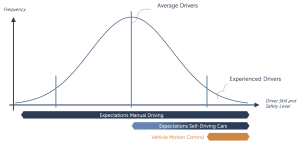Driverless Cars Must Perform Better Than the Average Driver

‘In the hype for autonomous driving, driverless cars will need to be able to handle critical situations on the same level as very skilled drivers’, says Johan Hultén, co-founder and CTO at Sentient.
What if autonomous vehicles were driven like a mediocre driver? Would anyone with a high level of driving skill accept being driven in a car like that? Would they [DF1] feel comfortable sending their children off to school, or to their leisure activities, in such an autonomous vehicle? Would the public accept autonomous cars that performed worse on the road than if a skilled driver were behind the wheel?
The answer to these questions is no. Neither skilled drivers nor the general public would accept autonomous driving that’s less safe than today’s cars being driven by experienced drivers.

Figure: Expectations regarding the capability to handle a critical dynamic situation.
However, in the hype for autonomous driving, little is said about the critical situations every car will have to deal with, situations such as aquaplaning and skidding on ice at high speed. We’re convinced that, when introducing autonomous driving, driverless cars will need to be able to handle critical situations on the same level as very skilled drivers.
That’s why S+ Motion Control makes the average driver an expert one, at the very least. Where traditional ESP prevents instabilities, e.g. oversteer, S+ Motion Control prevents instabilities and follows the intended path, keeping the vehicle in its lane.
/Johan Hultén CTO and co-founder of Sentient

